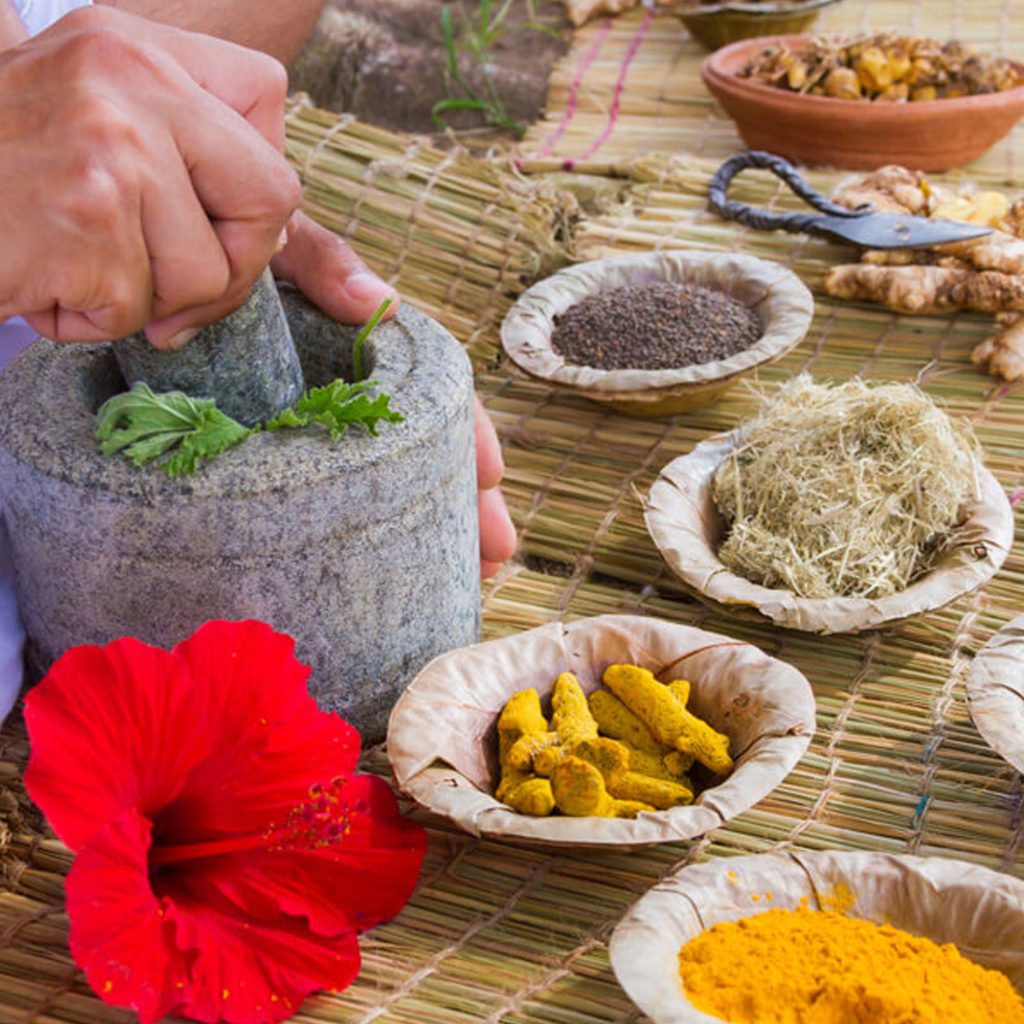No products in the cart.
Journey Through Herbal Healing: India’s Age-Old Secrets Unveiled
Ayurveda, an ancient Indian system of medicine, represents a profound journey into the world of herbal healing and ancient remedies. Rooted in a history that spans over thousands of years, Ayurveda embodies more than just a medical system; it is a philosophy and a way of life. Central to its practice is the use of a diverse array of herbs, each holding unique healing properties that have been meticulously studied and applied through generations. This system takes a holistic approach to health, emphasizing the balance of body, mind, and spirit. Unlike conventional medicine, which often focuses on treating symptoms, Ayurveda delves into the root causes of ailments, offering natural and comprehensive healing solutions. The principles of Ayurveda intertwine the physical aspects of health with the mental and spiritual, ensuring a balanced and harmonious state of being. In this context, ‘Herbal Healing’ is not just a practice but an age-old wisdom, offering ‘Ancient Remedies’ for modern ailments, reconnecting us with nature’s inherent capacity to heal and nurture.
History and Evolution
The history of herbal healing in India is as ancient as its civilization, deeply ingrained in the country’s cultural fabric. These ‘Natural Health Practices’ trace their roots back thousands of years, forming a cornerstone of traditional Indian medicine. Historically, sages and Ayurvedic practitioners meticulously documented various herbs and their healing properties in ancient texts, such as the Charaka Samhita. Over generations, this knowledge has been passed down orally and through written scriptures, evolving with each era while retaining its core principles. Adaptation to regional climates and cultures has enriched these practices, making them a diverse and integral part of India’s rich heritage in natural health and wellness.



Common Herbs and Their Uses
- Turmeric (Curcuma longa): Known for its anti-inflammatory and antioxidant properties. Commonly used to boost immunity, heal wounds, and treat respiratory conditions. It’s also used in skincare for its antiseptic qualities.
- Ginger (Zingiber officinale): Renowned for its digestive and anti-nausea properties. Frequently used to relieve indigestion, motion sickness, and inflammation. Ginger tea is a popular remedy for colds and flu.
- Tulsi (Holy Basil, Ocimum sanctum): Considered a sacred plant in India, it has adaptogenic properties, helping the body combat stress. Used to treat respiratory conditions, fever, and improve overall immunity.
- Neem (Azadirachta indica): Known for its antibacterial and antifungal properties. Widely used in treating skin conditions like acne and eczema, and as a natural pesticide in gardens. Also used in dental care products for its oral health benefits.
Integration with Modern Medicine
The integration of ‘Traditional Herbal Medicine’ into modern healthcare is a burgeoning field, marking a confluence of ancient wisdom and contemporary medical practice. In recent years, there has been a growing recognition of the value of Indian herbal remedies within the global medical community. This has led to collaborative efforts between traditional healers and modern medical practitioners, aiming to create a more holistic and comprehensive approach to health and wellness.
These collaborations often involve rigorous scientific research to validate the efficacy of traditional herbs, ensuring they meet modern safety and efficacy standards. For instance, clinical trials are conducted to study the impact of herbs like turmeric and neem on various diseases, thereby lending scientific credence to traditional practices. Additionally, medical curricula in some places are beginning to include courses on herbal medicine, bridging the gap between ancient and modern knowledge.
Such integration not only enhances the therapeutic arsenal of modern medicine but also ensures the preservation and respect of traditional practices. This synergy promises a future where healthcare is more inclusive, diverse, and attuned to natural, holistic healing methods.
Sustainable Practices and Conservation
Sustainable harvesting and cultivation are pivotal for the longevity of ‘Herbal Therapies’. With the rising popularity of these natural remedies, there’s an increasing need to ensure that medicinal plants are not over-harvested, leading to their depletion. Conservation efforts focus on sustainable agriculture practices that protect biodiversity and the environment. Educational programs are being implemented to teach farmers and harvesters about sustainable methods, ensuring a balance between use and preservation. Additionally, there’s a significant movement towards conserving the traditional knowledge associated with these herbs, often passed down orally through generations. This not only preserves the plants but also the rich cultural heritage they represent.
DIY Herbal Remedies
Incorporating ‘Traditional Herbal Medicine’ into daily ‘Natural Health Practices’ can be simple and effective. Here are a few easy-to-make recipes and tips using commonly available herbs:
- Turmeric Tea for Immunity:
- Ingredients: 1 tsp of ground turmeric, 1 cup of water, honey, and lemon juice to taste.
- Directions: Boil water and add turmeric. Simmer for 10 minutes. Strain the tea into a cup, add honey and lemon juice to taste. This tea is excellent for boosting immunity and reducing inflammation.
- Ginger Digestive Aid:
- Ingredients: A small piece of fresh ginger, 1 cup of water.
- Directions: Peel and grate the ginger. Boil water and add the ginger. Let it steep for about 5 minutes, then strain. Drink this tea to aid digestion, especially after meals.
- Tulsi (Holy Basil) Stress-Relief Tea:
- Ingredients: A handful of fresh Tulsi leaves, 1 cup of water.
- Directions: Boil water and add the Tulsi leaves. Steep for about 8 minutes, then strain. Drink this tea to help alleviate stress and anxiety.
- Neem and Coconut Oil Skin Salve:
- Ingredients: 2 tbsp of coconut oil, 1 tsp of neem powder.
- Directions: Mix neem powder with coconut oil to form a paste. Apply this salve to affected areas of the skin for antibacterial and antifungal benefits.
These simple recipes enable anyone to integrate the wisdom of traditional herbal medicine into their daily health practices, offering natural and holistic ways to maintain wellness.



Cultural Significance
In India, the practice of herbal healing transcends mere physical health, deeply intertwined with cultural and spiritual beliefs. ‘Ancient Remedies’, as integral to the Indian way of life, are not just seen as means to cure ailments but as essential elements in maintaining a holistic balance between the body, mind, and spirit.
These practices, rooted in Ayurveda and other traditional systems, are often associated with spiritual rituals and rites. For instance, the use of Tulsi (Holy Basil) is not only for its medicinal properties but also for its sacred status in Hinduism, symbolizing purity and promoting spiritual serenity. Similarly, the application of Neem is imbued with cultural rites, often used in cleansing rituals due to its purifying properties.
The approach to health in these traditions is preventative as much as it is curative, emphasizing the importance of harmony within oneself and with the natural world. This perspective views illness not just as a physical imbalance but potentially as a disruption in the spiritual or emotional equilibrium.
Therefore, the practice of using herbal remedies in India is deeply holistic. It’s a testament to the belief that healing the body is inextricably linked to nurturing the soul, reflecting a profound understanding of the interconnectedness of all aspects of life. The reverence for these ‘Ancient Remedies’ goes beyond their physical benefits, embodying a rich cultural and spiritual heritage that continues to influence health practices in India and around the world.
Challenges and the Future
The landscape of ‘Herbal Healing’ in India, while rich and diverse, faces significant challenges in the modern era. One of the primary concerns is the threat of commercialization. As the global market for natural health products expands, there is a risk that the commercial demand for herbs could lead to unsustainable harvesting practices, threatening the very plants that are essential to these healing traditions.
Another major challenge is the loss of traditional knowledge. As older generations of practitioners pass away, there is a danger that their invaluable knowledge, often transmitted orally, might vanish with them. This situation is exacerbated by the allure of modern medicine and technology, which can overshadow the value of traditional practices in the eyes of younger generations.
Looking to the future, it’s crucial to find a balance between preserving these ancient healing methods and adapting them to contemporary needs. Efforts are underway to document traditional knowledge, and there is an increasing interest in integrating herbal healing with modern healthcare systems. Educational initiatives are also important, both for training new practitioners and for raising public awareness about the benefits and proper use of herbal medicines.
Globally, the potential impact of India’s herbal healing practices is significant. As more people seek natural and holistic health solutions, Indian herbal medicine, with its rich history and holistic approach, offers valuable insights and treatments. However, this will require careful management to ensure that these practices are sustainable, effective, and accessible to those who need them. By addressing these challenges and leveraging its strengths, Indian herbal healing can play a vital role in shaping the future of global health and wellness.
Conclusion
The preservation and promotion of India’s ‘Herbal Therapies’ and ‘Ancient Remedies’ are of paramount importance, not only for their cultural and historical significance but also for their potential to address contemporary healthcare challenges. These age-old practices, honed over millennia, offer a treasure trove of knowledge in natural healing and wellness. They provide holistic solutions that complement modern medicine, focusing on prevention and the balance of the body, mind, and spirit. By integrating these ancient remedies with current medical practices, we can create a more comprehensive healthcare system that harnesses the best of both worlds.
Moreover, the global resurgence in the popularity of natural health solutions positions Indian herbal therapies as a vital component of the international wellness movement. Their potential to offer sustainable, effective, and holistic healthcare options is immense.
To explore more about these fascinating herbal therapies and ancient remedies, and how they can benefit your health and well-being, visit Roar Naturally. Dive into the world of natural healing and discover how these time-tested practices can enrich your life. Join us in this journey of health and wellness – Explore, Learn, and Transform with Roar Naturally!











